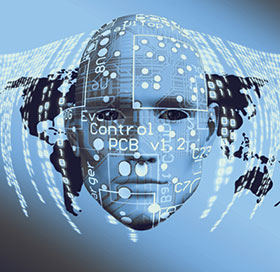

Estate security managers are facing a constant dilemma: how do they improve the security of their estates with ever-tightening budgets? Technology is moving at a bewildering pace and it is difficult to know what the most appropriate solution is: Do you rip and replace, or do you re-imagine and retrofit?
In addition, there’s the new(ish) buzz phrase doing the rounds – AI, or artificial intelligence. Can it improve security in the residential estate environment?
Analytics on steroids
Most surveillance systems rely primarily on a motion-triggered alarm system that either alerts guards on site directly through an alarm or sends the alert to an off-site monitoring company, allowing them to view the video images that led to the alarm. Unfortunately, as we all know, many of those alarms are false, often triggered by foliage blowing in the wind or pets.
AI surveillance systems, however, receive the video images from a camera triggered by motion detection and send the images to a classifier. This is where the magic of artificial intelligence takes place. Artificial intelligence can be described as the mimicking of human intelligence. Computers utilise logic and decision trees to reach conclusions.
Machine learning is a step further where the computer can semi-autonomously use statistical techniques to detect patterns and use inference to make decisions. Deep learning is yet another layer of artificial intelligence that harnesses multi-layered neural networks that progressively extract higher-level features from raw data (video images in surveillance).
It’s called ‘deep’ because there are more than two hidden layers. Computers making use of deep neural networks are able to train themselves and get better at classifying objects over time. This is similar to humans getting better with practice.
What this means is that it is possible to update existing cameras and hardware by simply “adding” video analytics enhanced by AI.
Cloud changes the game
In order to see the benefits of AI, estate managers have been conflicted by attempting to invest in the latest technologies, being high-end on-site servers/DVRs/NVRs with AI edge-based cameras, all this within ever-narrowing budget constraints. With cloud computing growing in popularity and reliability (and security), this opens a more affordable, scalable approach to AI and negates the need to replace the current camera infrastructure.
With the DeepAlert solution, the deep learning classifier usually sits in the cloud (although an on-premises option is also available). This is for two reasons. The first is that the cloud machines are receiving millions of images from multiple sites for processing and get better (more accurate) at processing over time with a little help from humans. The second is because the processing power required for accurate object classification is simply too large to deploy cost effectively on-site.
What does this all mean? It means that an analytics-enabled stream can accurately tell you what is in the scene when a camera is motion-triggered. If it is a harmless cat and not an intruder, then no alert is raised. This ‘second step’ in the filtering process reduces false positives by over 95% compared to simple motion-triggered alarms in a control room environment.

No need for expensive, new cameras
The classifier receives its video images from the RTSP feed of practically any camera (including analogue where it receives the stream from the NVR/DVR). So, no ripping and replacing. The system sends images to the cloud at a low rate when the camera is motion-triggered. The system is accurate, even with modest resolution (VGA) cameras at night. DeepAlert can also be used on IR camera streams with accurate person classification at up to 600 m in more highly tuned setups.
Deployment is usually using either a hub (between 6 and 15 stream options), straight to the cloud (no hardware required), or on a server using a virtual machine environment (larger applications of hundreds of cameras). The on-premises software is only performing the motion detection and is therefore very light on CPU requirements. Likewise, the hub only sends motion-triggered images and then only a few frames for analysing (object classification) in the cloud. This means that bandwidth requirements are extremely low if deploying hardware on-premises. The time taken between the motion trigger and the delivery of the analysed alert is approximately 3,5 seconds.
Integration into existing infrastructure
Many large estates make use of video management systems in their security infrastructure. DeepAlert can integrate with some of the larger video management systems, which allows controllers to view and respond to alerts using their normal interface.
However, for estates without a video management system, DeepAlert has its own web-based user interface. The interface allows security management to set up each individual camera, creating an exclusion zone to prevent unnecessary motion triggering. Users can also create rules per camera – what object class should be alerted, on which days and during which hours.
Finally, the alerts are delivered, viewed, and actioned on the Web and can also be delivered to any mobile device using the Telegram app. This means that guards on site can be alerted via their mobile phones at the same time as an off-site monitoring company is alerted.
The ‘installation’ (usually a hub) and setup can be completed within an hour or two, depending on the number of cameras connected, and is ready to work ‘straight out of the box’.
Now is the time to consider using AI on your estate as you can upgrade your old camera network to an AI-enabled, real-time alerting system that reduces false alarms and improves security without budget-busting hardware requirements.
| Tel: | +27 21 201 7111 |
| Email: | [email protected] |
| www: | www.deepalert.ai |
| Articles: | More information and articles about DeepAlert |
© Technews Publishing (Pty) Ltd. | All Rights Reserved.